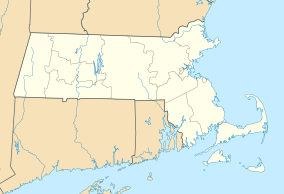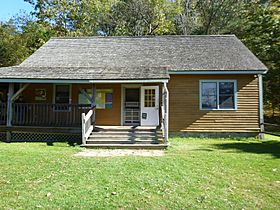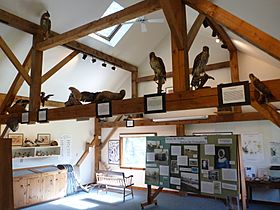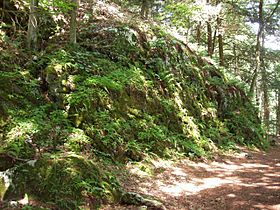Bartholomew's Cobble facts for kids
Quick facts for kids Bartholomew's Cobble |
|
|---|---|
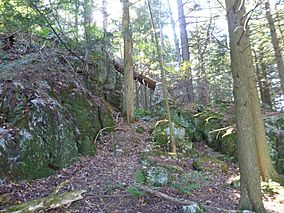 |
|
| Location | Massachusetts, United States |
| Established | 1946 |
| Operator | The Trustees of Reservations |
| Website | Bartholomew's Cobble |
Bartholomew's Cobble is a special natural area in southwest Massachusetts. It covers about 329 acres (1.3 square kilometers). This amazing place is a National Natural Landmark, which means it's recognized for its unique natural features. It's also a preserve for open space, farms, and wildlife.
You can find Bartholomew's Cobble in the village of Ashley Falls, right next to Canaan, Connecticut. It's home to over 800 different kinds of plants! This includes the largest variety of ferns in all of North America. It also has the most different types of living things in Berkshire County, Massachusetts. Plus, it has the most ground-nesting bobolink birds in Massachusetts. The area was named a National Natural Landmark in October 1971.
The preserve gets its name from two rocky hills called the "Cobbles." It also has flat areas along the Konkapot and Housatonic Rivers. You'll see active hayfields, pastures, and meadows. There's even a hill called Hurlburt's Hill, which is about 1,000 feet (300 meters) high. From there, you can see amazing views of The Berkshires, the Taconic Mountains, and the Housatonic River Valley. A group called The Trustees of Reservations has owned and managed this land since 1946. Visitors can enjoy hiking trails, an interpretive center, and a museum. Rangers also lead canoe trips on the Housatonic River during certain times of the year.
Contents
History of Bartholomew's Cobble
The word cobble comes from a German word, kobel. It usually means a small, rocky, rounded hill that stands out.
Early Inhabitants and Settlers
Long ago, the Mahican tribe lived on this land. Later, a man named Colonel John Ashley settled here. He was a leader during the American Revolution. The village of Ashley Falls is named after him. Colonel Ashley built a house near the Cobbles. This house, called the Colonel John Ashley House, is now a historic site. The Trustees of Reservations also manage it.
How Bartholomew's Cobble Got Its Name
The name "Bartholomew's Cobble" comes from a family who owned the land after Colonel Ashley. In 1838, Wyllis Bartholomew bought Colonel John Ashley's house and some land. He owned it until he passed away in 1846. His son, Hiram, then inherited it. In 1852, Hiram sold the land to his son, George. George farmed the land for many years. People started calling it Bartholomew's Cobble when George owned it.
Before The Trustees of Reservations took over in 1946, the property was used for farming and grazing animals. More land was added to the preserve over time. This happened through purchases and donations between 1963 and 2000.
Amazing Biodiversity at Bartholomew's Cobble
Bartholomew's Cobble has an incredible variety of plants and animals. This is called biodiversity. Several things make this area so special.
Why So Many Different Plants and Animals?
First, the location of Bartholomew's Cobble is unique. It's a place where many species reach the northern or southern edge of where they can live in North America. This means you can find plants and animals here that are rare in other nearby areas.
Second, the preserve sits where two different natural regions meet. One is the marble valley lowlands of The Berkshires (a type of rock formation). The other is the Taconic uplands (higher, hilly areas). This mix of landscapes creates many different habitats.
Third, the "Cobbles" themselves are made of two different kinds of rock. One is quartzite, which is an acidic rock. The other is marble, which is an alkaline (or calcareous) rock. This creates very different soil types right next to each other. These different soils allow many kinds of ferns and other plants to grow that usually don't live close together.
Plants of the Cobble
You can find many cool fern species here. Some examples include the walking fern, maidenhair spleenwort, and bulblet fern. There are also beautiful flowering plants. These include red columbine, herb Robert, bloodroot, and mayapple.
Forest and Field Life
West of the Cobbles, the land changes to open hay fields. You might see eastern red cedar trees there. Further on, there are forests with trees like red oak, eastern hemlock, and sugar maple. A rare plant called the great blue lobelia grows in these uplands. The hay fields are carefully managed to protect the homes of ground-nesting bobolink birds.
River Animals and Birds
Along the Housatonic and Konkapot Rivers, you'll find oxbow lakes (U-shaped lakes), wetlands, and open pastures. There are also forests right by the river, called riverine forests. Many animals live here, such as the great blue heron, bobcat, and New England cottontail. You might even spot a bald eagle! Trees like eastern cottonwood and American sycamore grow along the water.
Bartholomew's Cobble is also a very important place for migratory birds. Over 250 different kinds of birds have been seen here! This includes the bank swallow, bobolink, bald eagle, red-tailed hawk, and pileated woodpecker.
Fun Activities and Learning
Bartholomew's Cobble is located on Weatogue Road in Ashley Falls. It's open during daylight hours for everyone to enjoy. To protect the delicate plants and animals, please remember that no pets are allowed on the property.
Hiking Trails and Visitor Center
There are over 5 miles (8 kilometers) of hiking trails at the preserve. Some trails are a bit challenging, but they offer great views. One popular trail is The Ledges Trail. It's a self-guided walk that takes you over and around the rocky Cobbles.
The visitor's center and museum are great places to learn more. They have displays about the area's natural history and human history. You can see photographs, art, and even taxidermic displays of local animals, birds, and bird eggs.
Guided Tours and Conservation
The Trustees of Reservations offer guided tours led by naturalists. These experts can teach you all about the plants and animals. The money from these tours helps support important conservation work at Bartholomew's Cobble. This includes studying wildlife, controlling invasive species (plants or animals that don't belong), protecting endangered species, and restoring natural habitats.
Gallery
-
Maidenhair spleenwort and moss growing on Cobble ledge
See also


